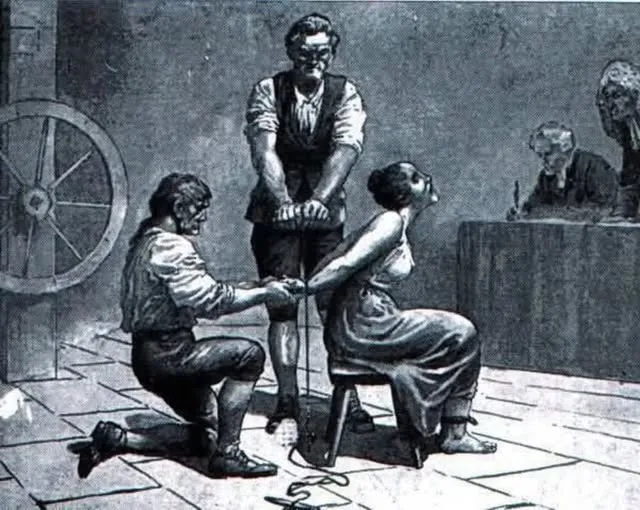I recently came across an old 19th-century engraving that stopped me cold. It shows a woman seated on a simple wooden stool, her face contorted in agony, while two men wrench her bound arms upward behind her back. In the background, a stern judge looks on as a clerk scribbles notes, and on the wall hangs the ominous spoked silhouette of a breaking wheel. The image is grim, theatrical, and utterly real in what it represents: the strapado—one of history’s most common and cruel judicial tortures.

What exactly is the strapado?
Also known as the “rope torture” or “reverse hanging,” the strapado (from the Italian strappare, “to pull”) was deceptively simple. The victim’s hands were tied tightly behind their back. A rope was attached to the bound wrists and thrown over a beam or pulley. The torturers then hoisted the victim off the ground by their arms, letting their full body weight yank their shoulders out of their sockets. Sometimes weights were added to the feet to increase the agony. In other versions—the one shown in the engraving—the victim remained seated or kneeling while the rope was pulled from the front, forcing the arms into an excruciating backward arc.
The pain was immediate and overwhelming: torn ligaments, dislocated shoulders, sometimes even broken bones. Yet the method was classified as “non-lethal” by the courts that used it, which allowed authorities to claim they weren’t technically violating laws against mutilation—before trial.
Where and when was it used?
The strapado was a European favorite from the late Middle Ages well into the 18th century. You’ll find it documented in:
- The Spanish and Portuguese Inquisitions
- Italian city-state tribunals
- German territorial courts under the infamous Carolina code (1532)
- Scottish and English witch trials
- French parlement interrogations
- Even some colonial American cases
It was considered a standard “question” (from the Latin quaestio, meaning torture) to extract confessions for everything from heresy and witchcraft to theft and treason. The logic was coldly utilitarian: a quick confession saved the state the expense and uncertainty of a full trial. Pain, in the eyes of the law, was just an efficient shortcut to truth.
The symbolism in the engraving
That giant wheel on the wall isn’t random decoration. It’s a Catherine wheel—the breaking wheel used for the most horrific public executions. Shattering a person’s limbs one by one with an iron bar before weaving the broken body through the wheel’s spokes was reserved for the worst criminals. Displaying it in the torture chamber was psychological warfare: “Confess now, or that is your future.”
Why this image still haunts us
Centuries later, we like to think we’ve outgrown such barbarity. Most countries banned judicial torture in the 18th and 19th centuries (Britain in the 1640s for common crimes, France in 1789, Prussia in 1754, etc.). The Eighth Amendment, Article 5 of the Universal Declaration of Human Rights, and countless treaties all proclaim that no one shall be subjected to torture.
Yet every time we hear about “enhanced interrogation,” waterboarding labeled as “not torture,” or secret CIA black sites, the ghost of the strapado stirs. The same arguments echo across centuries: It’s not really torture. It’s necessary. It works. The victim probably deserves it anyway.
The engraving isn’t just a historical curiosity. It’s a warning etched in ink and agony: the moment a society decides that certain people are outside the protection of humane treatment, the rope comes out again—whether it’s made of hemp or euphemism.
We’ve replaced the pulley and the breaking wheel with cleaner, more clinical methods, but the impulse to extract “truth” through suffering hasn’t vanished. It’s just learned to wear a suit and cite national security.
Look closely at that old picture the next time you feel smug about living in enlightened times. The woman on the stool could be any of us, once the wrong label is applied.
Because the distance between civilization and the torture chamber has never been more than one bad law, one panicked moment, or one quietly approved exception.





